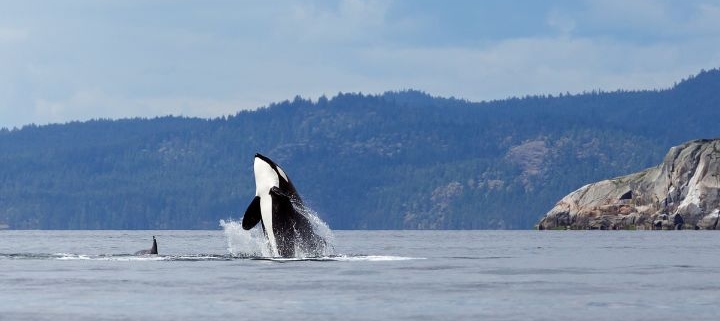Seattle Whale Watching Tours: Tips, FAQs & More
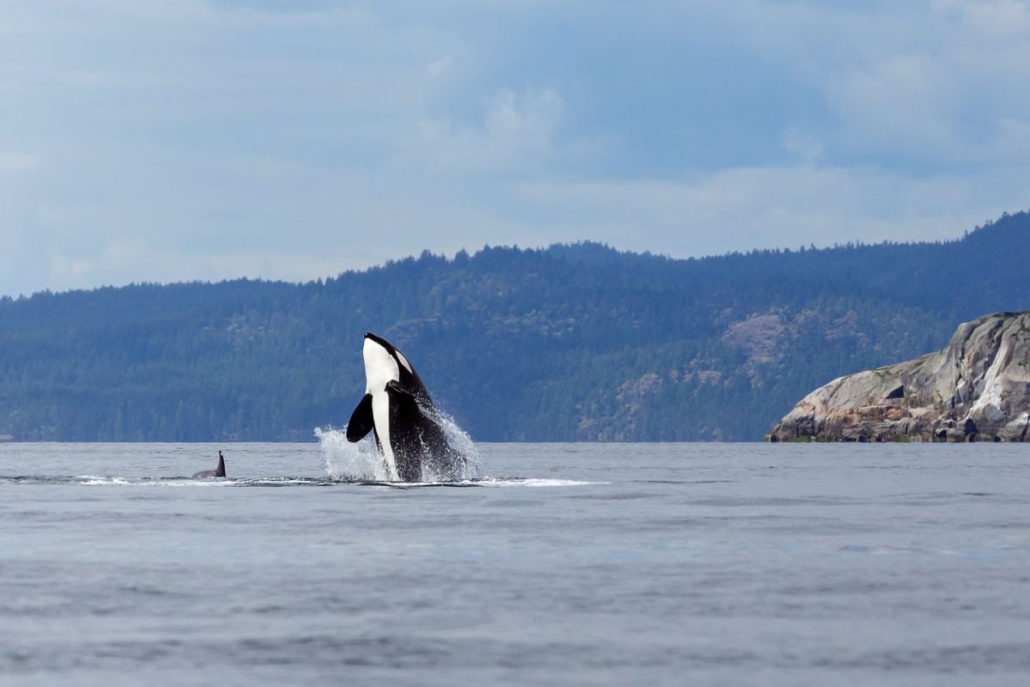
Few sights are as humbling as seeing a whale breach the ocean’s surface and slap its body back into the water. It puts the massiveness of Mother Nature on full display with a heart-pounding thrill that’s hard to equal. Of course, not every Seattle whale watching tour includes a breaching orca whale. But most do include a whale sighting, especially aboard San Juan Safaris whale watching tours.
PLEASE NOTE: San Juan Safaris is an active member of the Pacific Whale Watch Association (PWWA) and follows all guidelines for respectful and safe wildlife viewing. The Owner and Captain Brain served as president of the organization for three terms and is now an active board member.
Regulations for viewing orca whales require that boaters stay 200 yards away and keep clear of the whales’ path.
Southern Resident Orcas
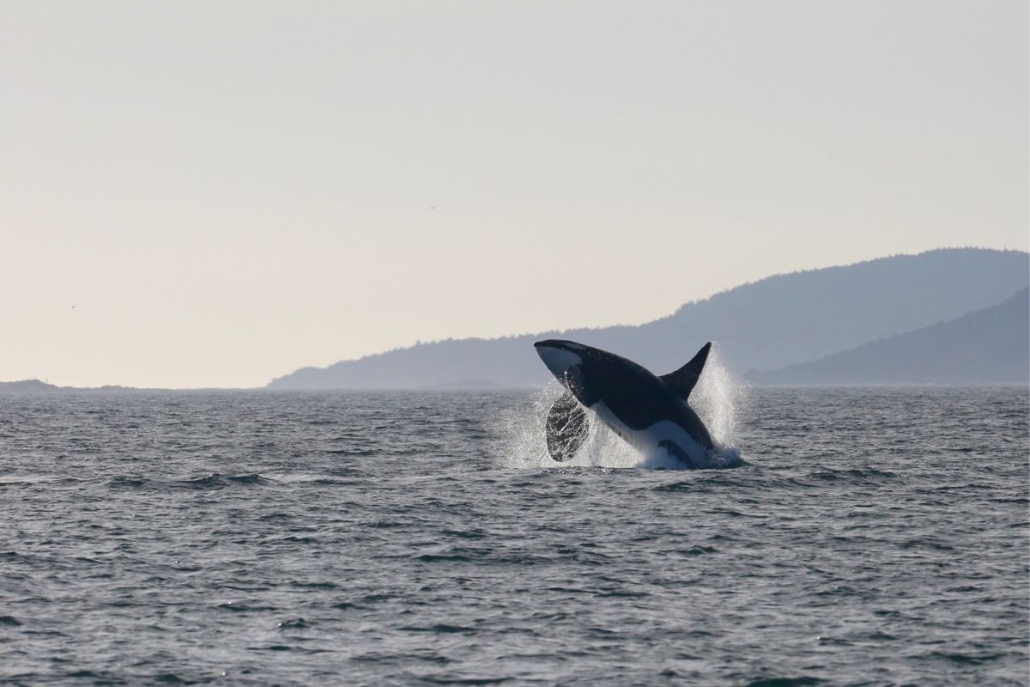
Southern Resident Orcas are salmon-eating orca whales who are most commonly seen in the Pacific Northwest from May through October. There are three distinct family groups in the Southern Resident Population, known as the J, K, and L pods. While these three pods interact, socialize, and breed together, they do not migrate from one pod to another.
Orca whales (aka killer whales) are members of the cetacean family, including dolphins and porpoises. Ceteacean is an ancient Greek and Latin word meaning “huge fish” or “sea monster.” While indeed very large, these mammals are highly intelligent, with complex social behaviors and family structures similar to humans.
The Southern Resident population is one of just three main types of orca whales found in the Pacific Ocean. (The three main types include offshore, transient, and resident). Unlike their mammal-eating cousins, these salmon-eating orcas have a smaller traveling range, summering in the Salish Sea and spending much of the winter along the Pacific Ocean’s coast.
Why is their travel pattern so predictable? Because they follow the salmon. A salmon-eating orca needs 100-300 pounds of food a day (roughly 40 salmon). Traditionally, 70% of this diet comes from Chinook salmon. In recent years, this hunt for food has forced them as far south as Monterey, California, and as far north as Southeast Alaska.
Wandering further is just one symptom of the declining salmon population. The primary concern is the devastating impact this diminishing food supply is having on the Southern Resident population, which numbers just 73 remaining members (as of September 2022).
Protecting the Southern Resident Orca Whales
Responsible wildlife viewing is one of the best ways to protect the Southern Resident orca whales. This is best achieved by following the Pacific Whale Watching Association’s (PWWA) safe viewing guidelines. Whale watching vessels, like San Juan Safaris, are often the first to see and report threats to whales, which typically include injuries or entanglements. Whale watching vessels also help alert the nearby boating community of whale activity in the area so they can slow down and use caution.
Spotting Southern Resident Orca Whales
Orcas are one of the most well-known icons of the Salish Sea, thanks to their handsome black and white markings and towering dorsal fins. Most commonly, you’ll see an orca whale spout, which is also known as blowing. This is when any cetacean rises from beneath the water’s surface to breathe.
While a beautiful sight to behold, there are a variety of more playful and exciting behaviors to keep an eye out for:
- Spyhopping — When an orca raises its head straight up in the water. This allows the orca to see what’s happening above the surface.
- Breaching — Arguably the most exciting behavior to encounter, this is when an orca leaps out of the water entirely and crashes back down on its back or side. The result is a loud splash or slapping sound. Breaching is used as a form of communication and play between orcas.
- Cartwheeling — In some respects, this might be considered an upside-down breach. It is when a whale throws its flukes and lower body out of the water, slapping it from one side to another. While cartwheeling, the whale’s head stay’s submerged. This is another move that’s believed to be used for both play and communication between whales.
- Porpoising — Also known as Speed Surfing, this is when a whale torpedoes in and out of the water in a rapid series of short, shallow arcs while swimming. This maneuver can help an orca reach up to 30 MPH, which means you better watch because they’ll pass by QUICK!
Transient Orcas (aka Bigg’s Orca Whales)
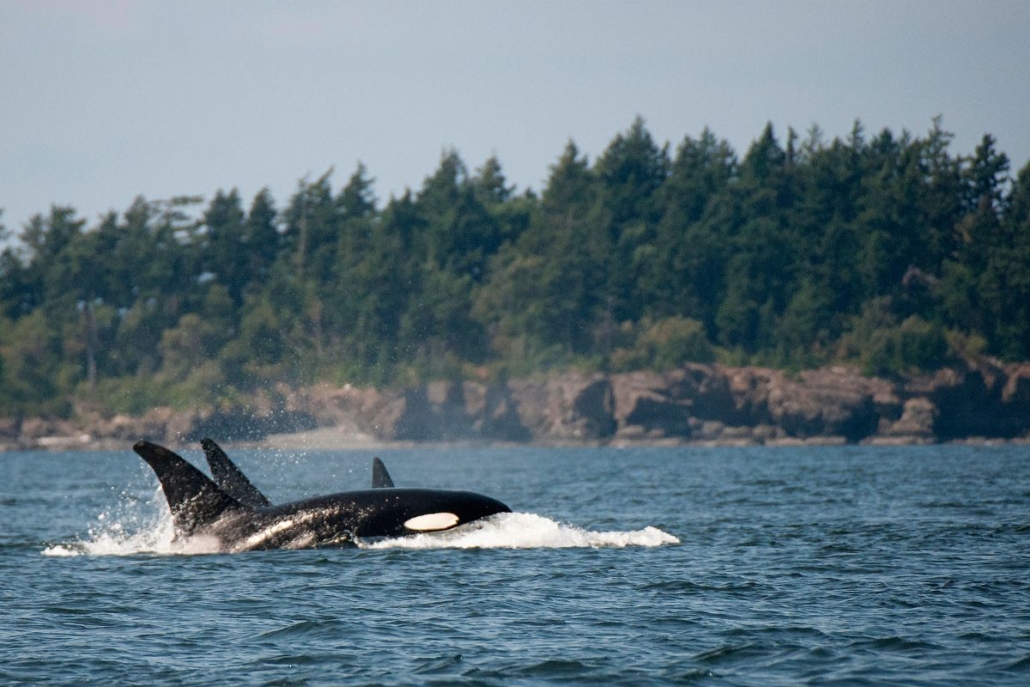
Transient orcas, also known as Bigg’s orca whales, are mammal-eating orca whales. Like their Southern Resident cousins, these whales are most commonly seen in the Salish Sea from May through October. While Bigg’s and Residents tend to be in the Salish Sea during the same time, their vocalizations are different, and these two populations do not interact. In fact, it appears they purposely avoid one another.
While their diet is still marine-based, their prey is larger than Resident Orcas – consisting mainly of seals, sea lions, porpoises, and the occasional larger whale. Transient orca whales tend to be slightly longer and heavier than Residents, roaming in groups that typically range from two to six. These small groupings are typically based on a female and her offspring, but they often change as animals mature and disperse.
Thanks largely to the fact that these whales have no natural predators (except perhaps another Bigg’s orca), the population is thriving. According to the Orca Network, it doubled in size from 1990 to 2018 — totaling more than 500 individuals. It’s believed that a subset (roughly 350) of these whales are most likely to be seen within the Salish Sea.
Spotting Transient Orcas in the Salish Sea
It can be quite challenging to determine if an orca is a Transient or Resident. While the Transient orca whales tend to be larger, establishing this size difference without a side-by-side comparison is next to impossible.
To the trained eye (like the whale watching experts at San Juan Safaris), it is possible to tell the orcas apart. In fact, these pros can often tell you who, specifically, you’re seeing among the Resident population.
That being said, there are three traditional differences in appearance between the Resident and Transient populations:
- Dorsal Fins — Transient dorsal fins tend to be sharper in appearance, with an almost triangular shape. Resident orca dorsal fins are often more curved.
- Saddle Patch – The Transient saddle patch is often wider than that of a Resident orcas.
- Eye Patch – The white eye patch on a Transient orca slopes down slightly, whereas the eye patches on Resident orcas run more horizontally to the white chin patch seen on their lower jaw.
Humpback Whales

The largest whale species in the Salish Sea, Humpback Whales are most commonly seen from May through October. However, this wasn’t always so. Whaling in the Salish Sea lead to nearly a century of absence. But since the waters became protected in the 1960s, the region has experienced what is known as the “Humpback Come Back.”
According to Ocean Wise, the rebounding population visiting the waters around the San Juan Islands is more than 500 large. Migratory by nature, these magnificent mammals spend their summers along the Pacific Northwest coast before returning to their winter breeding grounds (either off the Central American coast or Hawaii).
Spotting Humpback Whales
Distinguishing a humpback whale from other whales is relatively easy, thanks to their sheer size. They can reach up to 50-feet in length and weigh an impressive 40 tons. But it’s their giant pectoral fins that initially garnered them their Latin name, Megaptera novaeangliae, meaning “big wing of New England.” (The pectoral fins can grow up to 16 feet!)
Additionally, they have dark backs, light bellies, pleats on their throat, and a small hump in front of their dorsal fin — which earned them their “humpback” distinction. Like orcas, these enormous creatures often breach the water’s surface. With an acrobatic-like performance, they are known to twist and twirl through the air before slapping back down.
Humpback whales typically travel alone or in small pods (consisting of two or three whales), according to Whale Facts. These pods are most commonly a mother-young grouping. According to National Geographic, they “swim close together, often touching one another with their flippers with what appear to be gestures of affection.”
When hunting, humpbacks have been known to team up with one another to bubble-net feed. This is when the whales blow bubbles through their noses to encircle their food. The bubbles act like a net, pooling their prey (krill and fish) into a tight ball. The whales then swim from beneath the encircled prey, opening their mouths as they rise to the surface and gulp up their dinner.
Minke Whales
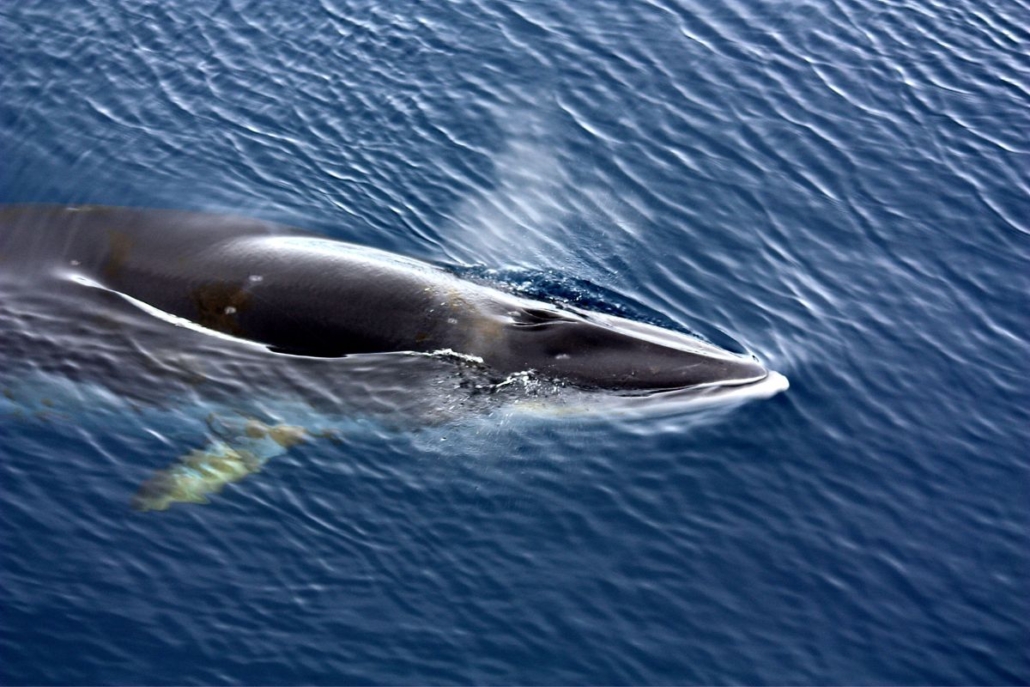
Minke whales are members of the baleen or “great” whale family. They are typically seen in the San Juan Islands from May through October, as they migrate to warmer water during the winter months. The smallest of the baleen whales, they weigh between five and ten tons and reach up to 30 feet in length.
Spotting Minke Whales
Typically solo travelers, you may occasionally see them in small groups of up to three. Most of their time is spent feeding, which requires the whales to capture a large amount of water in their mouth and then push the water back out, while catching small fish and plankton in their baleen (bristle-like strainers).
The minke whale can be distinguished by their broad, black back and small dorsal fin. Look closely, and you’ll also notice their white underside and white eye batches on both front flippers.
Not nearly as acrobatic as orcas or humpbacks, minke whales can sometimes be seen breaching the water’s surface. If you see a minke breach, don’t look away. They normally breach three times in a row and then dive down into the water.
Gray Whales
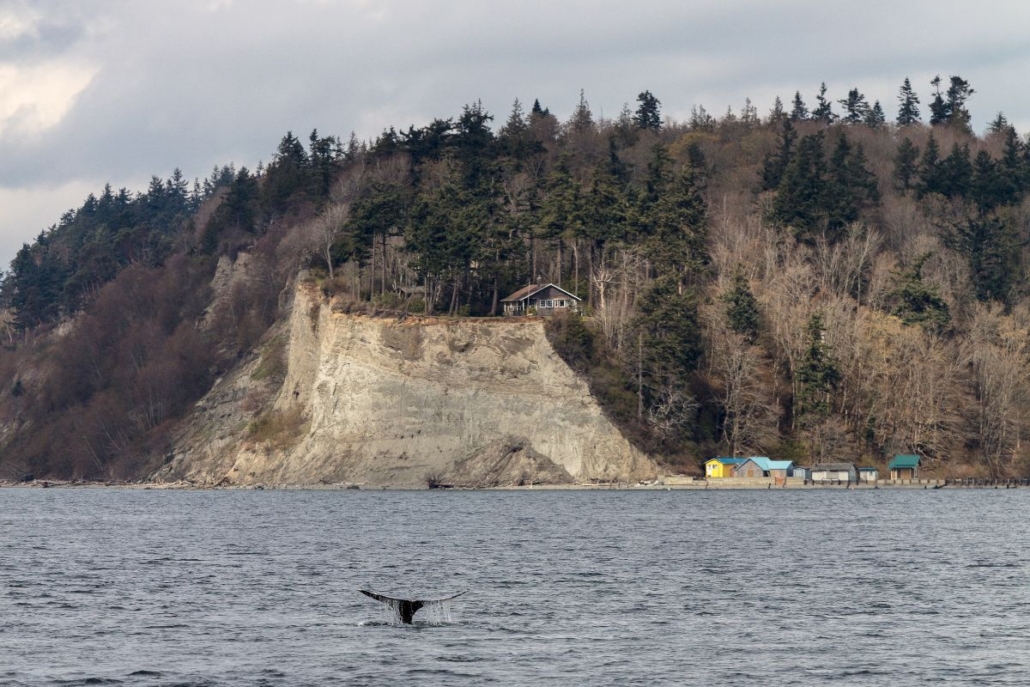
Like the groundhog in Philidelphia and the cherry blossoms at the University of Washington, the Gray Whale signals spring in the Pacific Northwest waterways. Typically seen in the Salish Sea between March and May, these mammals make the longest yearly migration in the world. (They travel up to 12,000 miles round-trip from Mexico’s Pacific Coast to the Bering and Chukchi Seas near Alaska.)
The grey whales which come to the Puget Sound are known as the North Puget Sound grays or ‘Sounders.’ It is believed they visit our slice of paradise thanks to the dense food population (namely shrimp) found in the tidal flats that surround Whidbey, Camano, and Hat/Gedney Islands, along with the nearby shorelines.
To feed, grey whales suck sediment and food from the sea floor, a practice that classifies them as bottom feeders. Grabbing a bite requires the large whales to roll on their sides and swim slowly along the ocean floorbed, filtering their food through coarse baleen plates. (The long trails of mud they create in the seafloor are known as “feeding pits”.)
Spotting Gray Whales
Because of their shallow feeding grounds, gray whales often swim very close to shore during high tide. One of the easiest ways to spot these enormous whales is to watch for their high, heart-shaped mist that blows when they surface. But keep in mind, they typically surface without warning. Watching closely and diligently is important to spot them.
After the surface, they typically dive to feed again. As they make their descent, their large tail (roughly 10 feet in width) can be seen flipping above the water.
What to Bring on a Seattle Whale Watching Tour
It’s best to dress in layers when whale watching, even during the summer months. This allows for bundling up or down as the temperatures change while out on the water. (Even on a bright and sunny day, it can be cool out at sea.)
Not sure what layers and/or gear to bring? Use this list as your guide:
- Hat & Sunglasses
- Sunscreen
- Binoculars
- Camera
- Water Bottle (no glass please)
- Snacks and/or Lunch
- Flat Shoes with Rubber Soles
- Rain Jacket or Windbreaker
- Gloves
- Motion Sickness Medication (If you are prone to motion sickness)
What Other Wildlife Could You See on a Seattle Whale Watching Tour?
With its lush landscape, the Pacific Northwest isn’t just known for its diverse whale population. The region is home a wide range of wildlife, including a variety of smaller mammals such as:
- Seals
- Sea otters
- Porpoises
- Sea lions
A host of birds can be seen, such as:
- Bald eagles
- Hooded mergansers
- Pelagic cormorant
- Common murre
- Tufted puffin
- Rhinoceros auklet
- Harlequin ducks
- Herring gulls
- Pigeon guillemots
- Pacific and common loons
- Great blue herons
Additional Frequently Asked Questions About Whale Watching in the San Juan Islands from Seattle
Can I Book a Whale Watching Tour Online?
Yes, you can book a Seattle Whale Watching tour online through our booking portal. These tours depart from our Kenmore terminal and take you to Friday Harbor. After your 45-minute scenic flight, it’s just a short walk to check-in with San Juan Safaris, who will provide your tour.
In order to book online, select the following options on our booking widget:
- Round Trip
- Departure Airport: Kenmore/Lake Washington
- Arrival Airport: Friday Harbor Whale Watching
How Likely Am I to See Whales with San Juan Safaris?
San Juan Safaris has a 90 percent success rate at seeing whales during their whale watching tours. That being said, there is no guarantee you will see whales.
How Long is the Flight to Friday Harbor?
Kenmore Air’s flights to Friday Harbor are roughly 45 minutes. They depart from our Kenmore terminal on Lake Washington and take you to the seaplane dock at the Friday Harbor Marina.
How Long is the San Juan Safaris Whale Watching Tour
San Juan Safaris whale watching tours are 3-4 hours long.
Will I Have Time to Explore Friday Harbor Before or After My Tour?
Typically, yes. You will typically have time before check-in and after your tour to explore Friday Harbor. The largest town in the San Juan Islands, it’s home to a large selection of farm-to-table restaurants, eclectic art galleries, novelty shops, and more.
During the summer months, the Friday Harbor Farmers Market operates on Saturdays at the heart of downtown. And if you find yourself wanting a fabulous cup of coffee without the need to wander, pop into the Riptide Cafe. The only waterfront coffee shop in Friday Harbor, it’s located right next to San Juan Safaris’ check-in desk.
Do I Need a Passport for the Tour?
Nope! These whale watching trips are in U.S. waters. No passport is necessary to travel to the San Juan Islands. Government-issued photo ID is required for adult passengers on domestic routes. Proof of age is required for Lap Infants on domestic routes.
Will I Get Seasick During the Tour?
Generally speaking, San Juan Safaris does not operate in rough waters. That being said, the ocean is unpredictable. It is possible that the waters can become choppy while you’re whale watching. Those who are prone to motion sickness may want to take motion sickness medication prior to boarding to avoid any unwanted symptoms.
How Close Will We Be to the Whales?
As an active member of the PWWA, San Juan Safaris all guidelines and laws for respectful wildlife viewing. By federal law, all vessels are required to stay 200 yards from transient whales and 100 yards from all other marine mammals in the U.S. waters.
These distances were established to help protect marine wildlife from harm and give them space to behave naturally. These distances still offer an exceptional viewing experience.
More Fun Things to do in the San Juan Islands
Tidepooling in the San Juan Islands
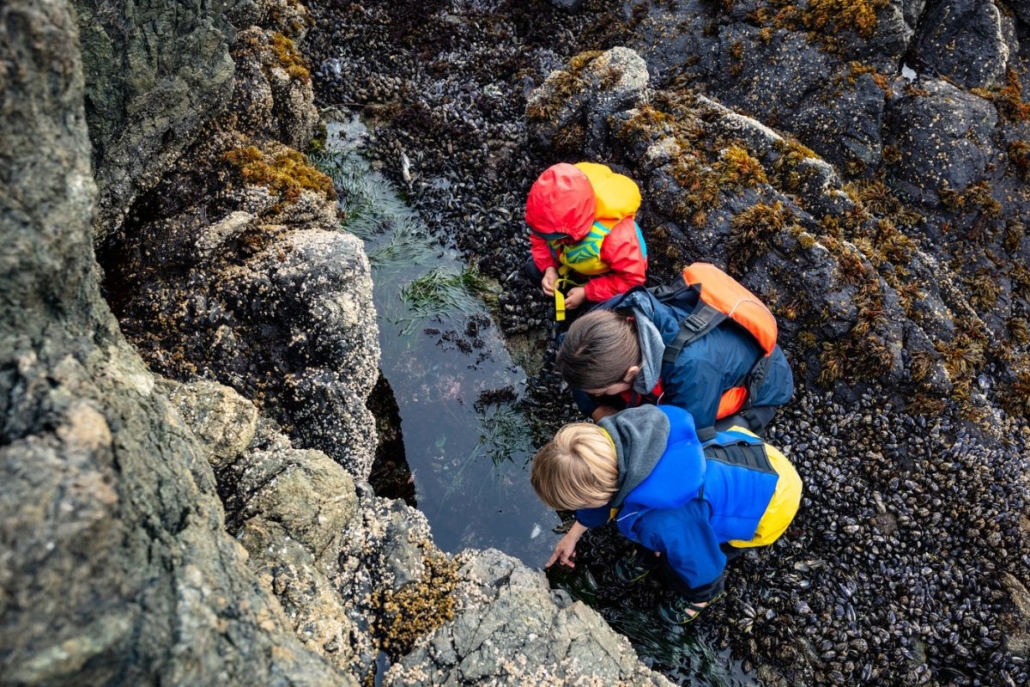
Places to Snap a Selfie on San Juan Island

